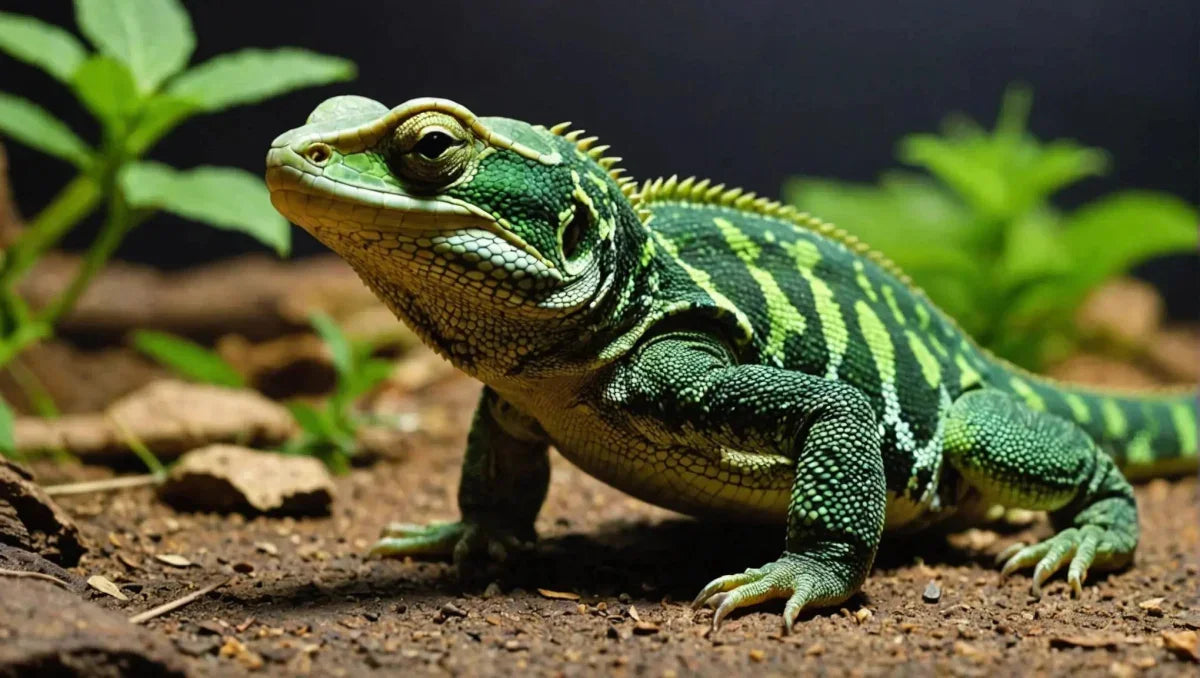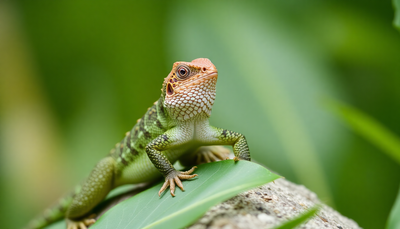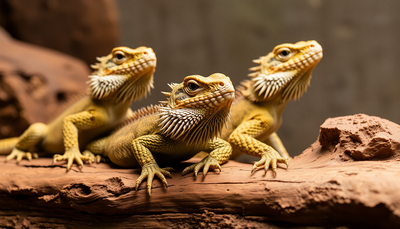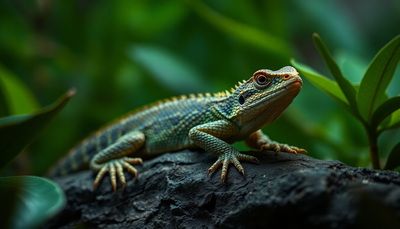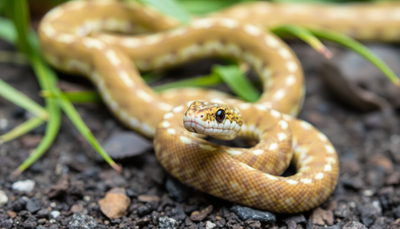Reptiles for Compact Habitats

Looking to bring a fascinating companion into your home, but limited on space? Delve into the captivating world of reptiles that thrive in compact habitats with our comprehensive guide. Whether you're a novice or a seasoned reptile enthusiast, this exploration will offer valuable insights into the most suitable species for smaller tanks. From the vibrant colors of the bearded dragon to the charming nature of the leopard gecko, we'll cover a range of reptiles well-suited for compact enclosures. Join us as we uncover the unique characteristics, care requirements, and captivating behaviors of these scaly companions. By the end, you'll be equipped with the knowledge to make an informed decision and create a fulfilling environment for your new reptilian friend.
Geckos Suitable for Small Tanks
Types of Geckos Suitable for Small Tanks
When considering geckos for small tanks, it's essential to choose species that thrive in confined spaces. Some suitable gecko species include the African Fat-Tailed Gecko, the Ground Gecko, and the Pygmy Gecko. These geckos are well-suited for smaller enclosures and are relatively low-maintenance, making them ideal for beginner reptile enthusiasts.
Habitat Requirements
Creating a suitable habitat for geckos in small tanks is crucial for their well-being. Despite the limited space, it's important to provide adequate hiding spots, climbing branches, and a shallow water dish for hydration. Additionally, maintaining the appropriate temperature and humidity levels is vital for the overall health of geckos. Utilizing substrate that retains moisture, such as coconut fiber or cypress mulch, can help maintain the necessary humidity levels within the enclosure. It's also important to include UVB lighting for species that require it, as it aids in their calcium metabolism and overall well-being.
Care Tips for Geckos in Small Tanks
While small tanks offer space-saving benefits, it's important to ensure that the essential needs of geckos are met. Regularly cleaning and maintaining the enclosure is paramount for their health. Feeding schedules should be consistent, offering a balanced diet of live insects and, if applicable, supplemental vitamins and minerals. Monitoring the gecko's behavior and overall health is crucial, as any changes may indicate potential issues requiring attention. Handling should be kept to a minimum, as geckos are generally more comfortable with limited interaction.
Geckos can thrive in small tanks when provided with suitable living conditions and proper care. By selecting the right gecko species, creating an optimal habitat, and diligently attending to their needs, small tank enthusiasts can experience the joy of keeping these captivating reptiles. With proper research and commitment, gecko enthusiasts can create a fulfilling environment for these remarkable creatures within the confines of a small tank.
Anoles: The Versatile Reptiles
Adaptability to Small Tank Environments
Anoles, also known as American chameleons, showcase remarkable adaptability to small tank environments, making them an ideal choice for reptile enthusiasts with limited space. These versatile reptiles are native to the southeastern United States, the Caribbean, and some Pacific islands, where they have adapted to various habitats, including forests, grasslands, and urban areas. When creating a habitat for anoles, it is crucial to replicate their natural environment by incorporating live plants, branches, and rocks to provide ample climbing opportunities and hiding spots. This not only mimics their natural habitat but also ensures their mental and physical well-being, allowing them to exhibit their natural behaviors such as basking, foraging, and basking in the warmth of a heat source.
Feeding and Nutrition
Anoles thrive on a diet primarily consisting of insects, with crickets, mealworms, and small roaches being staple food sources. It is important to ensure that the prey offered is appropriately sized for the anole's consumption to prevent choking hazards. Furthermore, supplementing their diet with gut-loaded insects and dusting them with calcium and multivitamin powders is essential for their overall health. Calcium supplementation is particularly important for anoles to prevent metabolic bone disease and maintain their bone health. Additionally, providing a shallow dish of clean water for drinking and misting the enclosure to maintain humidity levels is vital for their well-being.
Handling Considerations
When handling anoles, it is crucial to do so gently and minimize stress. Anoles are delicate creatures, and excessive handling can cause them distress. Additionally, always ensure your hands are clean to prevent the transfer of harmful substances or pathogens. It is advisable to limit handling to essential activities such as enclosure maintenance and health checks, allowing the anoles to feel secure in their habitat.
Anoles are captivating reptiles that can thrive in well-designed small tank environments. By understanding their unique habitat and dietary needs, enthusiasts can provide these versatile reptiles with a fulfilling and enriching life. Their adaptability, coupled with proper care and consideration, makes them an excellent choice for both novice and experienced reptile keepers.
Section: Snakes
Snakes are fascinating creatures that make unique and captivating pets. In this section, we will explore small snake species suitable for small tanks and delve into their feeding and space requirements.
Small Snake Species Suitable for Small Tanks
When considering a pet snake for a small tank, it's essential to select a species that thrives in a confined space. Corn snakes, king snakes, and sand boas are excellent choices for small tanks. These species are not only visually striking but also well-suited for smaller enclosures, making them ideal for beginner snake enthusiasts or those with limited space.
Feeding and Space Requirements
Feeding and space are critical aspects of snake care. Snakes typically feed on small rodents such as mice or rats. It's important to provide them with a suitable feeding schedule and monitor their nutritional needs. Additionally, ensuring that the tank provides adequate space for the snake to move, explore, and thermoregulate is vital for their well-being. Proper substrate, hiding spots, and temperature gradients are essential components of a snake's habitat to mimic their natural environment.
Creating the Right Environment
In addition to feeding and space considerations, creating the right environment is crucial for the well-being of pet snakes. It's important to replicate their natural habitat as closely as possible within the constraints of a tank. This includes providing a variety of substrates such as aspen shavings, cypress mulch, or coconut husk to mimic the ground cover found in their natural environment. Furthermore, incorporating naturalistic decor such as artificial plants, branches, and rocks can offer enrichment and hiding spots for the snakes, promoting their overall health and well-being.
Behavioral Enrichment
Snakes, despite their reputation, exhibit interesting and diverse behaviors. It's essential to provide environmental enrichment to stimulate their natural behaviors and prevent boredom. This can be achieved through the introduction of objects for climbing, burrowing, and exploring. Additionally, providing a varied and stimulating feeding routine, such as scenting prey or using food puzzles, can engage the snake's natural hunting instincts and provide mental stimulation.
Health and Veterinary Care
Regular health check-ups with a reptile veterinarian are crucial for maintaining the well-being of pet snakes. It's important to monitor their overall health, including weight, skin condition, and any signs of illness. Additionally, maintaining proper hygiene within the tank and providing clean water is essential for preventing infections and maintaining the snake's health.
The care of small snake species in small tanks encompasses various aspects, including their habitat, feeding, behavioral enrichment, and veterinary care. Understanding and meeting these diverse needs are essential for providing a fulfilling and healthy life for pet snakes.
Frogs and Toads
Species That Thrive in Small Tank Setups
Frogs and toads are fascinating creatures that can thrive in small tank setups. Some popular species suitable for smaller tanks include the African Dwarf Frog, Fire-Bellied Toad, and the Gray Treefrog. These species are well-suited to life in captivity and can adapt to smaller environments, making them ideal choices for hobbyists with limited space. These species are known for their adaptability and ease of care, making them perfect for beginners and experienced amphibian enthusiasts alike.
Creating a Suitable Habitat
Providing the right habitat for frogs and toads is essential for their well-being. It's important to simulate their natural environment as closely as possible within the confines of a tank. This includes selecting appropriate substrate, live or artificial plants, and providing adequate hiding spots. The setup should mimic their natural habitat, ensuring they feel secure and comfortable. Additionally, incorporating a shallow water area for species that require it, such as the African Dwarf Frog, is crucial for their overall health and happiness.
Temperature and Humidity Requirements
Maintaining the correct temperature and humidity levels is critical for the health of frogs and toads. Most species thrive within a temperature range of 65-85°F, although specific requirements may vary by species. It's essential to monitor and regulate the temperature within the enclosure using a reliable thermometer and, if necessary, a heating source. Humidity levels should also be carefully maintained, particularly for species that originate from tropical regions. Providing a misting system or regularly misting the enclosure can help achieve the necessary humidity levels, contributing to the well-being of the amphibians.
Diet and Feeding
Understanding the dietary needs of frogs and toads is vital for their overall health. These amphibians are typically carnivorous, and their diet may consist of live insects such as crickets, mealworms, and small feeder fish. It's essential to provide a varied diet to ensure they receive essential nutrients. Additionally, dusting their food with a reptile calcium supplement can help prevent nutritional deficiencies and promote bone health. The feeding frequency varies by species, so it's crucial to research the specific dietary requirements of the chosen species to ensure they receive adequate nutrition.
Health and Wellness
Regular observation and monitoring of frogs and toads are essential for detecting any signs of illness or distress. It's important to be familiar with the typical behavior and appearance of the species in order to identify any deviations that may indicate health issues. Maintaining a clean and well-maintained habitat, along with providing a balanced diet, will contribute to their overall well-being. Should any health concerns arise, consulting a veterinarian experienced in amphibian care is crucial to ensure proper diagnosis and treatment.
Frogs and toads can thrive in small tank setups when provided with the appropriate habitat, temperature, and diet. Their captivating behaviors and unique characteristics make them wonderful additions to the world of amphibian keeping, offering enthusiasts the opportunity to observe and appreciate these remarkable creatures in a controlled environment.
Conclusion
Selecting the best reptiles for small tanks requires careful consideration of the reptile's size, habitat requirements, and overall care needs. It's essential to prioritize the reptile's well-being and ensure that the tank size is suitable for their specific needs. By choosing the right reptile and providing a suitable environment, reptile enthusiasts can create a thriving and enjoyable habitat for their small-scale pets. Remember, proper research and preparation are key to successfully maintaining reptiles in small tanks.


